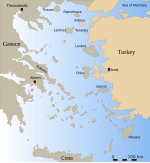Kasos
[1] There are several references to the island in the works of ancient authors, including as Amphe (Ἄμφη),[2] Astrabe (Άστράβη),[2] and Achni (Άχνη).
Concerning Kasos (Κάσος), Samuel Bochart (1674) and Victor Bérard (1902) suggested that it could derive from the Canaanite word kas 'foam', and that it is a doublet with Greek Achni (Άχνη).
[8] Lawrence Durrell is rather disparaging about the island, begrudging it a mere 22 words in a brief comparison to Karpathos, calling it a "smaller, stonier version of the same sort of thing.
[13] The French naturalist Charles Sigisbert Sonnini, visiting a few years after Savary, at the end of the 18th century, commented on the "very good wine" and "the honey which they gather [being] still, as in ancient times, abundant, and of excellent quality".
He writes (translated from the German): "A few days were enough to get an overview of the geological construction of this small island..." His results were published in 1890 in Vienna, along with a map.
In the early 1950s, the English travel-writer Robert Liddell visited the island for the memorial of the 1824 holocaust, that takes place every June.
[30] After a short period in the hands of the Knights of St John, Kasos was governed by the Venetian Cornaro family from 1306, before falling to Barbarossa and the Ottomans in 1537.
[5] The whereabouts of the Venetian administrative centre are not recorded; there are considerable structural remains in and around the Byzantine area of Panagia, with its picturesque group of early chapels known as "Six Churches" (Έξι Εκκλησίες).
Beginning in the later half of the 19th century, many emigrated from Kasos, initially to Egypt (about 5,000 people), then to Istanbul, Greece, USA and South Africa.
[5] On 12 May 1912, during the Italo-Turkish War of 1911–1912, after the so-called "Battle of Cassos" which took place on 29 January 1912, the island was occupied by the sailors of the Regia Marina ship Regina Elena.
In March 1935 the Greek naval warship Averof evacuated Eleftherios Venizelos from Helatros beach,[33] where today a commemorative bust marks the statesman's failed coup attempt and subsequent exile and death in Paris the following year.
[34] As the Second World War unfolded in the Aegean, in the spring of 1941 a small band of British special operatives based on Crete planned a raid on Kasos to assess the strength of the Italian garrison.
Dolphin, an armed caique, got as far as the islet of Elasa, some 50 km east of Kasos, before they were forced to abort their mission by German fighter aircraft.
[36] Dr. Raymond Mills[37] records being the medical officer on Kasos at the end of the war in charge of 3000 Greek and Italian refugees, who had escaped from the German occupation of the three islands of Rhodes, Kos and Leros; these men were repatriated later in 1945.
[40] The site first reached the attention of Western scholarship in 1845 as a result of a visit in September 1843 by the German classical archaeologist Ludwig Ross.
The associated cemeteries featured some burials with unique, inscribed lenticular discs, mainly from the 4th and 3rd centuries BC, some of which are on display in Fri's museum.
They write in their paper that the island's "position, geological history, small size and extreme aridity lead to a rather poor herpetofauna containing one amphibian... and six reptiles".


